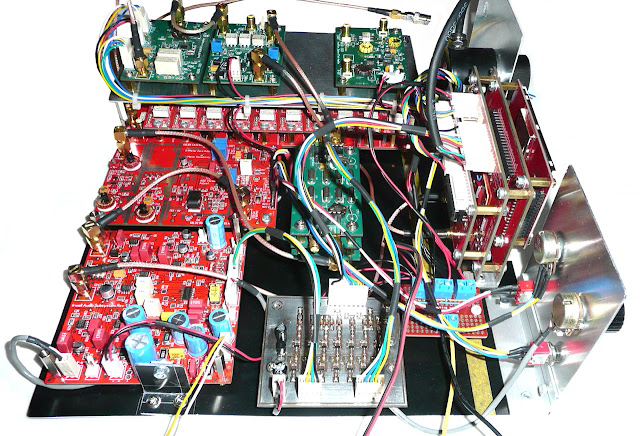My last blog post was in February of this year (2022) and it is hard to believe we are now at the end of the month of May and close to the halfway point of 2022!
I expect followers of the blog may have been left wondering if my Irwell HF Transceiver project has been abandoned but alas that is definitely not the case!
As I have said on previous occasions, the Irwell HF Transceiver is, and has been, a long-term project; and a personal goal that I intend to bring to fruition.
Sometimes I take a break from the Irwell to work on other projects and there are times when circumstances with life in general get in the way of hobbies and take greater preference.
So after a period of almost four months without a blog post, I feel compelled to provide an update on the Irwell HF Transceiver project. Work on the project has not been at a complete stand still, a couple of items have had to be addressed in order that the project can move forward.
"The Good, The Bad & The Ugly"
Allow me to start with the "Bad"
In true Apollo fashion, I have to report that “Houston, we have a problem” and that being with the Irwell Digital VFO!
To be more precise, an issue has come to light regarding the oscillator module of the VFO. This module contains not one but three Si5351 devices with one device being used per oscillator/clock signal. A single Si5351 device is actually capable of producing three separate clock signals on its own but with the caveat that there will be a degree of crosstalk present on the output signals.
I thought I was being clever with my idea of using a separate Si5351 for each clock signal and maybe i am but a problem emerged that had to be addressed before further progress on the project could be made.
My VFO module is based on software sourced from JA2GQP and JA2NKD, whom I am sincerely grateful to for sharing their work. I am not a software engineer myself so I have had to fumble my way through their code in order to make changes or add functions to suit my own needs. I have been successful in adding the multiplexer code for the three Si5351 devices, modifying the main Si5351 library file and adding code for the PCF8574 I2C I/O devices that control my filter modules as well as making various other changes.
When I designed the oscillator module, I used a separate 25MHz xtal for each of the Si5351s reference clocks and this turned out to be my downfall. There is nothing technically wrong with using a separate reference xtals for each of the Si5351s as long as each of the reference oscillators can be calibrated.
There is a saying, “A little knowledge is a dangerous thing" and this is true but in the spirit of ham radio experimentation, I prefer to align myself with the saying, "fools rush in" and I must confess to overlooking the fact that the source software only has a calibration routine for one 25MHz reference oscillator and not the three I included in my hardware. The effect of having uncalibrated reference oscillators resulted in a frequency discrepancy at the VFO output that got bigger as the frequency increased.
Having spent a degree of time designing the oscillator module and associated PCB, the sensible option to remedy the problem would be to add additional calibration routines to the software. This turned out to be easier said than done!
Time is free and priceless but once you spend it, there is no getting it back and I spent a lot of time trying to work out how to add additional calibration routines to the software but due to my lack of knowledge in software programing, I had to succumb to failure, as I was losing way too much valuable time that I could never get back!
And now for something "Good"
With failure there is always hope for a solution and in my case the humble TCXO or temperature controlled xtal oscillator was my redeeming saviour.
The existing VFO oscillator PCB does not have provisions for a TCXO module so it is inevitable that I will have to redesign the PCB to accommodate it.
Before I committed to re-engineering the PCB, I decided it would be sensible to test a TCXO module on the existing oscillator board to see how it performed and also to optimize component values.
In my spare parts stock, I found a FOX924B 25MHz TCXO that I had spare from another project. It is a miniature device measuring just 5.0mm by 3.2mm with an operating voltage of 3.3 V and a frequency stability of +/- 2.5PPM over its temperature range.
I cut a small piece of FR4 strip board (veroboard) to make a quick and dirty PCB to mount the TCXO and other components.
 |
| Preparation of strip board for TCXO module. |
Next I mounted the TCXO device, power supply decoupling capacitor and three 1nF capacitors to feed the oscillator output to each of the Si5351's. The orange and blue wires are for the 3.3 volt power feed and ground.
 |
| Components mounted on the strip board. |
Next is a zoomed in close up shot of the tiny PCB ready for mounting on the VFO oscillator PCB.
 |
| PCB shown enlarged for clarity. |
Finally here is the TCXO board mounted on the VFO oscillator PCB.
The image is a little blurred but you can clearly see the TCXO module mounted for testing. The yellow arrows highlight small holes I had to drill on the PCB to pass the TCXO output signal wires through, these then connect onto the clock signal PCB pads previously occupied by the three individual clock xtals.
The data sheet for the Si5351 device specifies that an external clock oscillator should be connected to the XA pin with a signal amplitude of 1Vpp I used 1nF coupling capacitors from the TCXO module to the Si5351 devices and measured just over 1Vpp.
Having run the modified VFO oscillator PCB for a few weeks, I am happy to report that the TCXO behaves fine and there are no longer any calibration issues. In hindsight I should have considered using a TCXO as part of the original VFO design, as it offers better stability and is advantageous for digital modes.
I have redesigned the VFO oscillator PCB to take the TCXO and hope to have the revised PCBs back from fabrication soon. Once I get one of the revised boards built up I will update this blog post with further details.
And now last but not least "The Ugly"
As the Irwell has developed and grown in size, so has the rat's nest of wiring and the chaotic mess I have precariously worked with for so many months, in reality it is a small wonder that the lot has not gone up in smoke so I decided it was time to untangle the mess and make the project a little more manageable.
I fabricated a temporary chassis out of aluminium sheet salvaged from an old computer case and other scrap material that I had to hand. The end result now shows the project having some resemblance to a transceiver 😉.
The following images show the new temp chassis. Note the limited number of controls on the front panel, the final build will have many more controls and switches and be housed in a custom-built case with a larger footprint.
 |
| Click to enlarge image! |
 |
| Click to enlarge image! |
 |
| Click to enlarge image! |
What you can see in the images above are mainly the receive modules, some will be shared with the transmit section which will be constructed on a separate compartmented sheet mounted on the underside of the receive sections.
The project is a real labour of love and not for the faint-hearted, even in its current state I use it on a daily basis as my main shack receiver be it listening to SSB signals on the ham bands or my local AM radio station.
Now that I have addressed the aforementioned problems, it is time to move on and get back to work on the transmit sections and I might try adding the second mixer stage and roofing filter into the receiver so stay tuned for the updates!
For part 2 of revisiting the Digital VFO Oscillator module, click here.
Project files will be made available via the Groups.io platform by joining my G6LBQ community group, where you can discuss my projects, ask questions and help others.
Joining my group is free. Just click on the button below.
Until next time...





onwards and upwards
ReplyDelete